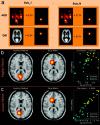Method for multimodal analysis of independent source differences in schizophrenia: combining gray matter structural and auditory oddball functional data
- PMID: 16108017
- PMCID: PMC6871470
- DOI: 10.1002/hbm.20166
Method for multimodal analysis of independent source differences in schizophrenia: combining gray matter structural and auditory oddball functional data
Abstract
The acquisition of both structural MRI (sMRI) and functional MRI (fMRI) data for a given study is a very common practice. However, these data are typically examined in separate analyses, rather than in a combined model. We propose a novel methodology to perform independent component analysis across image modalities, specifically, gray matter images and fMRI activation images as well as a joint histogram visualization technique. Joint independent component analysis (jICA) is used to decompose a matrix with a given row consisting of an fMRI activation image resulting from auditory oddball target stimuli and an sMRI gray matter segmentation image, collected from the same individual. We analyzed data collected on a group of schizophrenia patients and healthy controls using the jICA approach. Spatially independent joint-components are estimated and resulting components were further analyzed only if they showed a significant difference between patients and controls. The main finding was that group differences in bilateral parietal and frontal as well as posterior temporal regions in gray matter were associated with bilateral temporal regions activated by the auditory oddball target stimuli. A finding of less patient gray matter and less hemodynamic activity for target detection in these bilateral anterior temporal lobe regions was consistent with previous work. An unexpected corollary to this finding was that, in the regions showing the largest group differences, gray matter concentrations were larger in patients vs. controls, suggesting that more gray matter may be related to less functional connectivity in the auditory oddball fMRI task.
Hum Brain Mapp, 2005. (c) 2005 Wiley-Liss, Inc.
Figures








References
-
- Alfano B, Amato U, Antoniadis A, Larobina M (2002): Segmentation of MR brain images through discriminant analysis. Italy: Report RT262/02. - PubMed
-
- Andreasen NC, Paradiso S, O'Leary DS (1998): “Cognitive dysmetria” as an integrative theory of schizophrenia: a dysfunction in cortical‐subcortical‐cerebellar circuitry? Schizophr Bull 24: 203–218. - PubMed
-
- Andreasen NC, Nopoulos P, O'Leary DS, Miller DD, Wassink T, Flaum M (1999): Defining the phenotype of schizophrenia: cognitive dysmetria and its neural mechanisms. Biol Psychiatry 46: 908–920. - PubMed
-
- Ashburner J, Friston KJ (2000): Voxel‐based morphometry—the methods. NeuroImage 11: 805–821. - PubMed
-
- Bell AJ, Sejnowski TJ (1995): An information maximisation approach to blind separation and blind deconvolution. Neural Comput 7: 1129–1159. - PubMed
MeSH terms
Grants and funding
LinkOut - more resources
Full Text Sources
Medical

